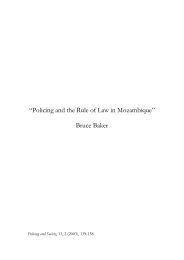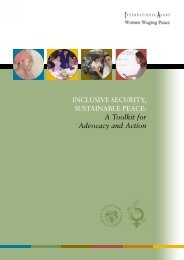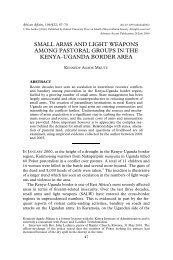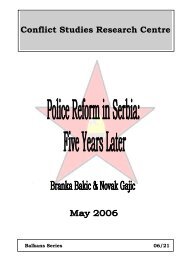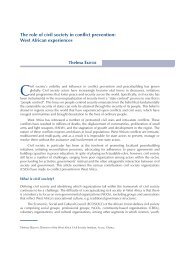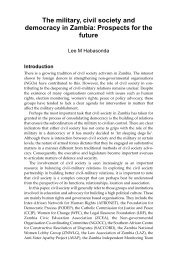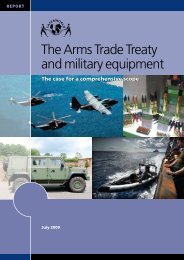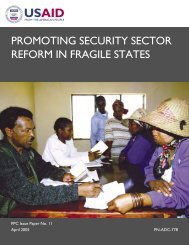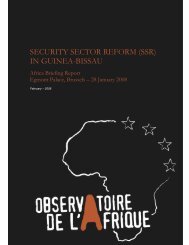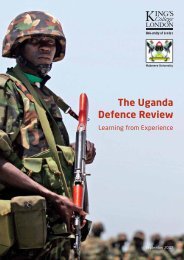AFGHANISTAN'S ELECTION CHALLENGES
AFGHANISTAN'S ELECTION CHALLENGES
AFGHANISTAN'S ELECTION CHALLENGES
Create successful ePaper yourself
Turn your PDF publications into a flip-book with our unique Google optimized e-Paper software.
34<br />
Afghanistan’s Election Challenges<br />
Crisis Group Asia Report N°171, 24 June 2009 Page 18<br />
Hedayatullah Amin Arsala, who announced a female<br />
vice-presidential nominee, Kabul MP Shenkai Zahin<br />
Karokhail, although she later stepped down. Initially,<br />
there were seven female vice-presidential nominees<br />
along with two presidential nominees: Shahla Atta,<br />
another MP for Kabul (although originally from Kandahar)<br />
and Frozan Fana, the widow of the aviation<br />
minister assassinated in 2003. Former Taliban commander<br />
Abdul Salaam Rocketi, who topped the<br />
Wolesi Jirga polls in Zabul in 2005, also put his name<br />
forward.<br />
1.2. Provincial council polls<br />
Countrywide 3,324 candidates nominated themselves<br />
for the 420 seats in 34 provincial councils. 132 This includes<br />
over 500 candidates for the 29 seats on the Kabul<br />
provincial council, double the number of candidates<br />
from 2005. Across Afghanistan there was an increase<br />
of around 130 candidates on preliminary nominations<br />
in 2005, but further analysis showed stark regional differences.<br />
The northern region had 65 more candidate<br />
nominations, the north east 204 and the central highlands<br />
26. In the less secure areas, numbers were down,<br />
with 220 fewer candidates in the south east than in<br />
2005, 157 fewer in the south, 95 fewer in the east, and<br />
seventeen fewer in the west.<br />
The number of female candidates increased to 342 from<br />
286 in 2005. Of the quarter of council seats reserved<br />
for women, only two lack sufficient candidates to fill<br />
them (one each in Uruzgan and Kandahar) compared<br />
to five in 2005. 133 Reflecting the general trend, however,<br />
while there was an overall increase in female<br />
candidates, the numbers have decreased in ten provinces,<br />
mainly in insurgency-hit areas. This reflects the<br />
impact of threats against women in public life in these<br />
areas. Many are moving or withdrawing from the public<br />
eye; for example, in Gardez at least one of the<br />
three female councillors is no longer based in the<br />
province. 134 The overall increase in female candidates<br />
does not necessarily indicate progress in women’s<br />
empowerment. It may simply reflect a better understanding<br />
of the system, with local power-holders hav-<br />
132 A handcount of the preliminary lists obtained slightly<br />
different results with 3,332 candidates of which 344 were<br />
women. All the figures used – except the two totals – are<br />
from Crisis Group’s count. The variations are small and<br />
general patterns should be clear. These were the initial<br />
nominations and as will be discussed further below some<br />
candidates later dropped out or were excluded through the<br />
vetting process.<br />
133 Nangarhar (one), Zabul (one) and Uruzgan (three).<br />
134 Crisis Group interviews, provincial councillors, Gardez,<br />
1 April 2009.<br />
ing seen the advantage of women’s seats, which can<br />
be won with fewer votes. 135<br />
Fewer candidates in some areas may result from better<br />
organisation and not just intimidation. In Kandahar,<br />
where there are only 3.9 male contenders for each of<br />
the eleven general seats (not including the four reserved<br />
women’s seats), there has been a lot of behind-thescenes<br />
work to reduce the number of candidates before<br />
election day. Overall, however, the effect of the insecurity<br />
on political expression appears stark, with over<br />
fifteen male candidates for every general seat in<br />
Bamiyan compared to fewer than five per seat in insecure<br />
areas such as Uruzgan, Farah, Paktia and Zabul.<br />
The vast majority of candidates – 88 per cent – put<br />
themselves forward as independents, with five provinces<br />
having no official party candidates at all. 136 A<br />
total of 36 parties ran official candidates but twenty of<br />
those have only one or two candidates – in several cases<br />
only women. Indeed, one fifth of women candidates<br />
were officially affiliated with political parties. This<br />
greater proportion suggests that women seek the protection<br />
and campaign resources a party can offer and/or<br />
the groupings see value in female seats which may<br />
require far fewer votes to win. Of the new “democratic”<br />
parties, Hizb-e Jamhuri Khawahani Afghanistan,<br />
led by Sebghatullah Sanjar who heads a policy unit in<br />
the presidential palace, has the most (thirteen) officially<br />
affiliated candidates.<br />
Most political party activity is in the north, with the five<br />
northern provinces having 143 official party candidates<br />
compared to nine in the five southern provinces. 137<br />
Junbish had the largest number, with 89 candidates<br />
spread across ten northern, north-eastern and western<br />
provinces, followed by Mohaqqeq’s Hizb-e Wahdat<br />
with 51 candidates across eleven provinces. Hizb-e<br />
Islami Afghanistan, which managed to register as an<br />
official political party after the 2005 polls, stood in the<br />
largest number of provinces, with 40 candidates in fourteen<br />
provinces – the highest number (ten) in Nangarhar,<br />
its eastern heartland. A party representative there said<br />
they had divided the province into ten geographic areas<br />
and selected a candidate for each. Jamiat, probably<br />
the least organised of the former tanzims, showed a<br />
complete lack of discipline in Balkh, with 28 people<br />
on the party ticket when there are only nineteen provincial<br />
council seats. Junbish, generally highly organ-<br />
135 Crisis Group interview, Western diplomat involved with<br />
southern Afghanistan, Kabul, 14 May 2009.<br />
136 Panjshir, Khost, Nuristan, Zabul and Uruzgan.<br />
137 The five northern provinces are Samangan, Balkh, Jawzjan,<br />
Sar-i Pul and Faryab; the five southern ones are Nimroz,<br />
Helmand, Kandahar, Zabul and Uruzgan.




